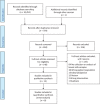Presence of Ebola virus in breast milk and risk of mother-to-child transmission: synthesis of evidence
- PMID: 33113592
- PMCID: PMC8048832
- DOI: 10.1111/nyas.14519
Presence of Ebola virus in breast milk and risk of mother-to-child transmission: synthesis of evidence
Abstract
To help inform global guidelines on infant feeding, this systematic review synthesizes evidence related to the presence of the Ebola virus (EBOV) in breast milk and its potential risk of viral transmission to the infant when breastfeeding. We relied on a comprehensive search strategy to identify studies including women with suspected, probable, or confirmed EBOV infection, intending to breastfeed or give breast milk to an infant. Our search identified 10,454 records, and after deduplication and screening, we assessed 148 full texts. We included eight studies reporting on 10 breastfeeding mothers and their children (one mother with twins), who provided breast milk samples for assessment. EBOV was detected via RT-PCR or viral culture in seven out of ten breast milk samples. Four out of the five-breastfed infants with EBOV-positive breast milk were found positive for EBOV infection, and all of these EBOV-positive infants died. Since previous reports have detected EBOV in tears, saliva, sweat, and contaminated surfaces, with the current evidence, it is not possible to conclude with certainty that breast milk was the main route of EBOV transmission.
Keywords: Ebola virus; breast milk; breastfeeding; mother-to-child transmission; perinatal transmission; vertical transmission.
© 2020 The Authors. Annals of the New York Academy of Sciences published by Wiley Periodicals LLC on behalf of New York Academy of Sciences.
Conflict of interest statement
The authors declare no competing interests relevant to this review. In the interest of full disclosure, S.M. has an equity interest in a startup commercializing some of his research focused on point‐of‐care assays for determining micronutrient status.
References
-
- WHO . 2018. Ebola virus disease—Democratic Republic of Congo.
-
- CDC . Ebola virus disease distribution map: cases of Ebola virus disease in Africa since 1976. Accessed February 10, 2020. https://www.cdc.gov/vhf/ebola/history/distribution-map.html.
-
- WHO . 2020. Ebola virus disease. Accessed February 10, 2020. https://www.who.int/news-room/fact-sheets/detail/ebola-virus-disease.


